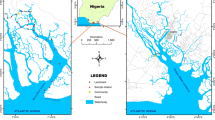Abstract
The concentration of total hydrocarbons in the water effluent from an oil field was 5.6 mg/L and resulted in concentrations of 46 to 85μg/L in the receiving stream. Total hydrocarbons were 55,000 times more concentrated in the sediment than in the water, ranging from 979 (778) to 2,515 (1,263) mg/kg. Saturated hydrocarbons contributed most to the total hydrocarbon concentration in both water and sediment. Naphthalenes were found in stream water, but not in sediment. Cadmium, chromium, copper, lead, and zinc were detected in water and sediment. Zinc was elevated in the sediment, probably because an organic zinc complex was used by the oil company during processing to enhance oil-water separation. Species diversity of macrobenthos was reduced below the discharge, as evidenced by the almost complete elimination of Plecoptera and Trichoptera. Shannon-Weaver diversity index values ranged from 3.4 at the upstream control station to 1.2 to 1.7 below the oil field effluent. The representation of Diptera increased from 10% of the total insects at the least polluted station to 46% at the station containing the most dissolved hydrocarbons. On the basis of our findings, discharge of oil into fresh water should be closely regulated to prevent the development of concentrations in water and sediment of the receiving stream that would alter the structure of macrobenthos communities and thereby threaten the fishery resources.
Similar content being viewed by others
References
American Public Health Association, American Water Works Association, and Water Pollution Control Federation: Standard methods for the examination of water and waste water, 13 ed. New York: American Public Health Association (1971).
Anderson, J. W., R. G. Riley, and R. M. Bean: Recruitment of benthic animals as a function of petroleum hydrocarbon concentrations in the sediment. J. Fish. Res. Board Can.35, 776 (1978).
Armstrong, H., W. K. Fucik, J. W. Anderson, and J. M. Neff: Effects of oil field brine effluent on sediment and benthic organisms in Trinity Bay, Texas. Mar. Environ. Res.2, 55 (1979).
Cherry, D. S., and R. K. Guthrie: Toxic metals in surface waters from coal ash. Water Resour. Bull.13, 1227 (1977).
Holz, D. D., F. L. Mayer, Jr., and R. C. Tindle: A core type sampler for pesticide studies. Prog. Fish Cult.34, 117 (1972).
Lock, M. A., R. R. Wallance, D. R. Barton, and S. Charlton: The effects of synthetic crude on microbial and macroinvertebrate benthic river communities-Part I: Colonization of synthetic crude oil contaminated substrata. Environ. Poll. Series A, 207 (1981).
Lytle, T. F., and J. S. Lytle: Sediment hydrocarbons near an oil rig. Estuarine and Coastal Mar. Sci.9, 317 (1979).
Moles, A., S. Bates, S. D. Rice, and S. Korn: Reduced growth of coho salmon fry exposed to two petroleum compounds, toluene and naphthalenes in fresh water. Trans. Amer. Fish. Soc.110, 430 (1981).
McAuliffe, C. D.: GC determination of solvents by multiple phase equilibration. Chem. Technol.1, 46 (1971).
Newbury, T. K.: Possible accumulation of heavy metal around offshore oil production facilities in the Beaufort Sea. Arctic32, 42 (1979).
Rosenberg, D. M., and A. P. Wiens: Community and species response of Chironomidae (Diptera) to contamination of fresh waters by crude oil and petroleum products, with special reference to the Trail River, Northwest Territories. J. Fish. Res. Board Can.33, 1955 (1976).
Hannon, C. E., and W. Weaver: The mathematical theory of communication. Urbana, Ill: University of Illinois Press (1963).
Simard, R. G., I. Hasegawa, W. Bandaruk, and C. E. Headington: Infrared spectrophotometric determination of oil and phenols in water. Anal. Chem.23, 1384 (1952).
Simpson, K. W.: Abnormalities on the tracheal gills of aquatic insects collected from streams receiving chlorinated or crude oil wastes. Freshwater Biol.10, 581 (1980).
Snedecor, G. W.: Statistical methods. Ames, Iowa; Iowa State University (1965).
Snow, N. B., and D. M. Rosenberg: The effects of crude oil on the colonization of artificial substrates by zoobenthos organisms. Fish. and Mar. Ser. Res. Div. Technol. Rep. 551. Winnipeg: Freshwater Institute (1975).
USEPA (United States Environmental Protection Agency): Quality criteria for water. Washington, DC: U.S. Environmental Protection Agency (1976).
Wilhm, J. L.: Range of diversity index in benthic macroinvertebrate populations. J. Water Pollut. Control Fed.42, 221 (1970).
Wilhm, J. L. and T. C. Dorris: Biological parameters for water quality criteria. Bioscience18, 477 (1968).
Winner, R. W., M. W. Bossel, and M. P. Farrell: Insect community structure as an index of heavy metal pollution in lotic ecosystems. Can. J. Fish. Aquat. Sci.37, 647 (1980).
Woodward, D. F., P. M. Mehrle, Jr., and W. L. Mauck: Accumulation and sublethal effects of a Wyoming crude oil in cutthroat trout. Trans. Amer. Fish. Soc.110, 437 (1981).
Author information
Authors and Affiliations
Rights and permissions
About this article
Cite this article
Woodward, D.F., Riley, R.G. Petroleum hydrocarbon concentrations in a salmonid stream contaminated by oil field discharge water and effects on macrobenthos. Arch. Environ. Contam. Toxicol. 12, 327–334 (1983). https://doi.org/10.1007/BF01059410
Received:
Revised:
Issue Date:
DOI: https://doi.org/10.1007/BF01059410




